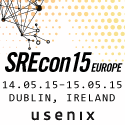sponsors
help promote


general information
Venue:
Google
Gordon House
Barrow Street, Dublin 4
Ireland
Questions?
About SREcon?
About Registration?
About Sponsorship?
usenix conference policies
SREcon15 Europe Programme
All events will take place at The Foundry, which is located inside Gordon House on Barrow Street, Dublin 4, at Google Dublin, unless otherwise noted.
Download the SRECon15 Europe Attendee List (Conference Attendees only)Attendee Files
(Registered attendees: Sign in to your USENIX account to download this file.)

 Attendee List - SREcon15 Europe
Attendee List - SREcon15 Europe
Thursday, May 14, 2015
| 07:30–09:00 | ||
Badge Pickup |
||
| 08:00–09:00 | ||
Continental BreakfastLounge |
||
| 09:30–10:00 | ||
|
|
||
| 10:00–11:00 | ||
|
|
|
|
| 11:00–11:30 | ||
Break with RefreshmentsLounge |
||
| 11:30–13:30 | ||
|
|
|
|
| 13:30–14:30 | ||
LunchGarage Cafe |
||
| 14:30–16:30 | ||
|
|
|
|
| 16:30–17:00 | ||
Break with refreshmentsLounge |
||
| 17:00–17:30 | ||
|
|
|
|
| 17:30–18:00 | ||
|
|
||
| 18:30–20:30 | ||
Reception at The Westin DublinSponsored by Facebook |
||
Friday, May 15, 2015
| 08:30–09:00 | ||
Continental BreakfastLounge |
||
| 09:00–11:00 | |||
|
|
|
|
|
| 11:00–11:30 | |||
Break with RefreshmentsLounge |
|||
| 11:30–13:30 | |||
|
|
|
|
|
| 13:30–14:30 | ||
LunchLounge |
||
| 14:30–16:30 | |||
|
|
|
|
|
| 16:30–17:00 | |||
Break with refreshmentsLounge |
|||
| 17:00–18:00 | ||
|
|
||








connect with us